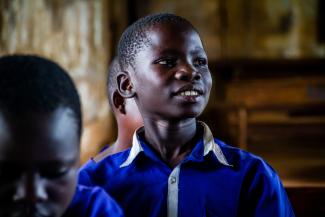U.S. development assistance to Uganda began in 1962, when the country gained its independence. Working in close cooperation with the government and people of Uganda, USAID began investing in health, education, and agriculture—areas that continue to serve as benchmarks for our work today.
Although priorities have evolved over the past five decades, USAID’s commitment to Uganda continues to focus on improving people’s livelihoods. Strong economic growth has lowered poverty, reduced the rate of HIV/AIDS infections, and improved access to education, but challenges remain, such as a high school drop-out rate and low quality of education. A large number of children remain vulnerable to abuse, exploitation and violence; and the country’s youth face high unemployment rates when they finish school. USAID’s work in Uganda supports U.S. policy objectives in peace and security, democracy and governance, health and education, economic growth, and humanitarian assistance.
EDUCATION
USAID partners with the ministry of education and sports to improve the quality of basic education in primary grades in uganda. Our work focuses on improving reading in early grades in english and 12 local languages, increasing hiv/aids knowledge and reducing school-related gender-based violence (SRGBV). Usaid strengthens the teaching workforce by improving professional training, providing teaching and learning materials like books, and delivering ongoing mentoring and coaching to trained teachers.
By focusing interventions on the interconnections of language, teaching methods and instructional materials, usaid can significantly improve young learners’ reading and literacy scores within targeted schools and districts. Coupled with hiv/aids and srgbv prevention, usaid expects to increase students’ success and continued enrollment in school, promote healthy behaviors and lay the foundation for the socio-economic benefits that are proven to come when students—especially girls—complete their education.
YOUTH AND CHILD DEVELOPMENT
Of Uganda’s 17 million children under the age of 18, more than half are in vulnerable situations that require external support. An estimated 11 percent of all Ugandan children are orphans. Such conditions negatively affect the health, skills development and nutrition of these children, jeopardizing their chances for a prosperous future. USAID delivers multiple programs to prevent violence against children and youth in homes, schools, and communities and to improve medical and law enforcement response to identified cases of violence.
USAID partners with the Ministry of Gender, Labor and Social Development to ensure orphans and other vulnerable children receive support services that reduce their vulnerability during times of need. USAID’s programming employs an integrated approach to address the complex challenges they face. This includes empowering children, youth, and their caregivers to access core services like education and health care; strengthening systems to provide these core services delivery systems; and improving coordination of community-based services for efficiency and effectiveness along a range of care needed by each vulnerable child. Comprehensive case management and service provision is building resilience of the children and their families, enabling them to lead healthier, more educated, and stable lives.

Karin Bridger/USAID
